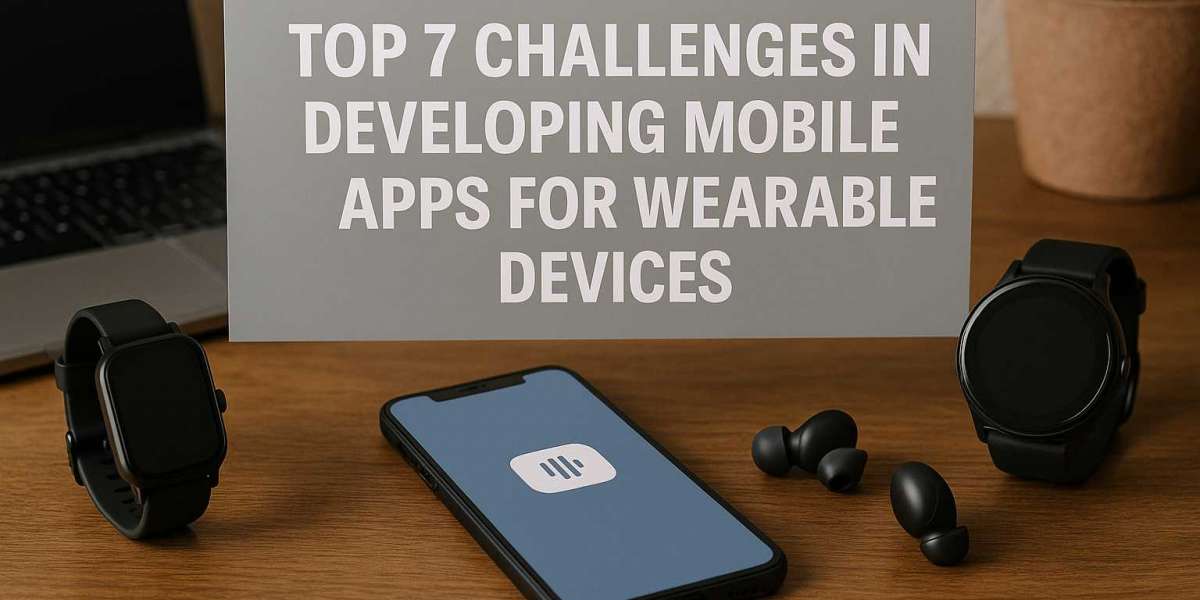Wearable technology, from smartwatches and fitness trackers to augmented reality glasses, has seamlessly integrated into daily life, offering convenience and real-time data at a glance. This burgeoning market presents exciting opportunities for Mobile App Development, promising innovative user experiences and new ways to interact with digital information. However, developing applications for these compact, context-aware devices comes with a unique set of challenges that differ significantly from traditional smartphone app development.
Here are the top 7 challenges faced by developers building mobile apps for wearable devices:
1. Limited Screen Size Unique UI/UX Design
The most immediate and apparent challenge in wearable app development is the diminutive screen real estate. Unlike smartphones with ample display areas, wearables feature tiny screens, demanding a fundamentally different approach to user interface (UI) and user experience (UX) design.
Information Density: There's minimal space to display information, forcing developers to prioritize the most critical data and features. Clutter quickly leads to an unusable interface.
Interaction Constraints: Traditional touch-and-type interactions are often cumbersome or impossible. Wearables rely more on taps, swipes, voice commands, and haptic feedback. Designing intuitive gestures that are discoverable and comfortable for users is key.
Glanceability: Wearable apps are often used for "micro-interactions" – quick checks for notifications, health stats, or simple controls. The design must facilitate immediate comprehension without requiring deep navigation.
Aesthetics vs. Functionality: Balancing a visually appealing design with extreme minimalism and core functionality is a delicate act. Every pixel and interaction needs to be purposeful.
Mitigation Strategies: Developers must embrace a "less is more" philosophy. Prioritize essential functions, use clear and concise text (or even better, visual icons), leverage haptic feedback for alerts, and design for quick, single-action interactions. Extensive user testing on actual wearable devices is crucial to refine the UI/UX for real-world scenarios.
2. Hardware Constraints (Processing Power, Memory, Storage)
Wearable devices are inherently small, which translates directly into limitations in their internal hardware. They possess less powerful processors, significantly less RAM, and constrained storage compared to modern smartphones.
Performance Optimization: Apps must be exceptionally lightweight and optimized to run smoothly on limited hardware. Resource-heavy operations, complex animations, or extensive background processing can lead to lag, crashes, or unresponsiveness.
Memory Management: Developers must be meticulous with memory allocation, minimizing memory footprint to prevent the app from being terminated by the system or impacting overall device performance.
Storage Limitations: Storing large amounts of data, media, or complex app resources directly on the wearable is often not feasible. This necessitates reliance on cloud storage or synchronization with a companion smartphone.
Mitigation Strategies: Efficient coding practices are paramount. Developers should focus on native development where possible to leverage platform-specific optimizations, minimize third-party library dependencies, and offload complex computations or data storage to the paired smartphone or cloud backend. Continuous performance profiling and optimization throughout the Mobile App Development lifecycle are essential.
3. Battery Life Optimization
One of the most critical factors for user satisfaction with any wearable device is its battery life. Users expect their smartwatches or fitness trackers to last at least a full day, if not longer, on a single charge. Apps that excessively drain battery power quickly become unpopular and are often uninstalled.
Sensor Usage: Wearables are rich in sensors (heart rate, accelerometer, GPS, etc.), but continuous or inefficient use of these sensors can rapidly deplete the battery.
Connectivity: Frequent data transfers via Bluetooth or Wi-Fi, especially if poorly managed, are significant power consumers.
Screen Activity: Keeping the screen on or having intensive graphics/animations constantly running also consumes substantial power.
Background Processes: Apps running complex operations in the background, even when not actively in use, can be detrimental to battery life.
Mitigation Strategies: Developers must implement aggressive power-saving techniques. This includes batching data transfers, using low-power modes for sensors where appropriate, optimizing networking calls, and ensuring background processes are minimal and efficient. Utilizing platform-specific APIs designed for power efficiency (e.g., Google's Ambient Mode for Wear OS) is also crucial.
4. Connectivity Data Synchronization
Most wearable devices are "tethered," meaning they rely on a companion smartphone for full functionality, including internet connectivity, complex processing, and displaying more detailed information. Establishing and maintaining seamless, reliable connectivity and data synchronization between the wearable and the smartphone is a persistent challenge.
Bluetooth Dependency: Bluetooth Low Energy (BLE) is the primary communication protocol, but its stability can be affected by distance, interference, and device variations. Dropped connections or slow re-connections frustrate users.
Data Consistency: Ensuring that data (e.g., fitness stats, notifications, settings) is accurately and consistently synchronized between the wearable and the companion app, often in real-time, is complex. Inconsistencies erode user trust.
Offline Functionality: Designing the app to gracefully handle situations where the wearable temporarily loses connection to the smartphone is important. What minimal functionality can the app still provide offline?
Platform-Specific APIs: Each wearable platform (e.g., Wear OS, watchOS) has its own set of APIs for inter-device communication, adding complexity for cross-platform Mobile App Development.
Mitigation Strategies: Implement robust error handling for connectivity issues. Prioritize essential data for real-time sync and batch less critical data. Utilize background synchronization capabilities offered by platforms. Thoroughly test connectivity under various real-world conditions (e.g., varying distances, congested environments, low battery).
5. Data Security Privacy
Wearable devices are intimate, collecting highly sensitive personal data, including health metrics (heart rate, sleep patterns), location data, and sometimes even biometric identifiers. Protecting this information from breaches and ensuring user privacy is a paramount concern and a significant challenge.
Sensitive Data Collection: The sheer volume and sensitivity of data collected by wearables make them attractive targets for cybercriminals.
Limited Security Resources: Due to their size and power constraints, wearables often have less robust security hardware and software compared to smartphones, potentially making them more vulnerable.
Data in Transit: Ensuring data is encrypted during transfer between the wearable, companion app, and cloud servers is critical. Bluetooth connections, if not properly secured, can be susceptible to eavesdropping.
Compliance: Adhering to strict data protection regulations (e.g., GDPR, HIPAA) is complex, especially when dealing with health data across different jurisdictions.
Mitigation Strategies: Prioritize security by design from the outset of the Mobile App Development process. Implement end-to-end encryption for all sensitive data. Utilize secure authentication protocols (including multi-factor authentication where feasible). Conduct regular security audits and penetration testing. Ensure transparency with users about what data is collected and how it's used, providing clear opt-out options.
6. Platform Fragmentation Compatibility
The wearable ecosystem is fragmented, with various operating systems (e.g., Wear OS, watchOS, proprietary OSs from brands like Fitbit or Garmin) and device types (smartwatches, fitness bands, smart rings, AR/VR headsets). This diversity poses significant compatibility and development challenges.
Multiple SDKs and Frameworks: Developers often need to learn and work with different Software Development Kits (SDKs) and programming languages for each platform, increasing development time and cost.
Feature Discrepancies: Not all features or APIs are available across all platforms. A feature seamlessly implemented on one platform might be impossible or require a complex workaround on another.
Testing Complexity: Ensuring an app functions correctly and consistently across a wide range of devices, operating systems, and form factors requires extensive and often costly testing.
Ecosystem Integration: Wearable apps often need to integrate with existing mobile app ecosystems (e.g., Apple Health, Google Fit), adding another layer of complexity.
Mitigation Strategies: Carefully choose the target platforms based on market research and target audience. Consider cross-platform development frameworks (e.g., Flutter for Wear OS) for broader reach, but be aware of their limitations for highly native or performance-intensive features. Design a modular architecture that allows for platform-specific adaptations without major code overhauls.
7. Contextual Awareness Micro-Interactions
Wearable apps are meant to be seamlessly integrated into a user's life, providing relevant information and functionality at the right moment, often without requiring explicit user input. Designing for this "contextual awareness" and enabling efficient "micro-interactions" is a subtle yet profound challenge.
Right Information, Right Time: The app must intelligently filter and present information that is immediately relevant to the user's current activity, location, or physiological state, without overwhelming them with unnecessary data.
Minimizing Cognitive Load: Users glance at wearables for seconds, not minutes. Information must be digestible at a glance, and actions must be intuitive and require minimal cognitive effort.
Leveraging Sensors for Context: Effectively utilizing device sensors (e.g., accelerometer for activity, GPS for location, heart rate monitor for health) to infer user context and trigger appropriate app behavior without draining battery or compromising privacy.
Non-Visual Interactions: Incorporating haptic feedback, subtle sounds, and voice commands to provide information or allow interaction without requiring the user to look at the screen.
Mitigation Strategies: Focus on defining clear use cases for each micro-interaction. Prioritize "push" information (e.g., notifications) over "pull" information (requiring active search). Design for different user states (e.g., active, passive, sleeping). Utilize ambient modes to display essential information with minimal power consumption. Thorough contextual testing is vital to ensure the app enhances, rather than disrupts, the user's natural flow.
Conclusion
Developing mobile apps for wearable devices is an exciting frontier in Mobile App Development, but it demands a deep understanding of their unique constraints and user interaction paradigms. From the limitations of tiny screens and constrained hardware to the complexities of battery optimization, data security, and seamless connectivity, each challenge requires innovative solutions and a user-centric mindset. By proactively addressing these hurdles, developers can create truly impactful and indispensable wearable applications that enrich the digital lives of users.








